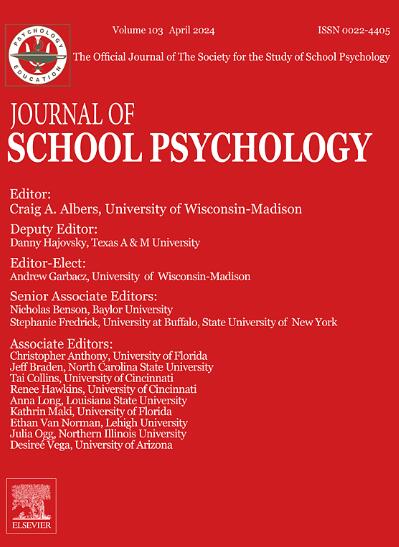The CARES classroom observation tool: Psychometrics of an observational measure of culturally responsive practices
IF 4.1
1区 心理学
Q1 PSYCHOLOGY, SOCIAL
引用次数: 0
Abstract
There is growing interest in improving and assessing teachers' use of culturally responsive practices (CRP) in the classroom, yet relatively few research-based approaches exist to address these measurement gaps. This article presents findings on the psychometric properties of a newly developed classroom observation measure of CRP, called the CARES Observational Assessment Tool, where CARES refers to five theorized domains of CRP. We used a sample of 268 30-min video observations across urban classrooms (Grades 4–9) from the Measures of Effective Teaching Project (Bill and Melinda Gates Foundation, 2014). These videos were scored using the CARES to establish initial construct validity of the measure, assess measurement invariance across teacher and student racial composition, and evaluate convergent, divergent, and concurrent validity within a nomological validity network utilizing item analysis and exploratory structural equation modeling. Results confirmed the five-factor structure of the CARES and reduced the original 41-item version of the CARES to a 19-item classroom observation tool (ω = .73; CFI = .977, TLI = .952, RMSEA = .028, SRMR = .030). Configural measurement invariance was unable to be established across student and teacher racial groups, raising important questions about CRP measurement in the context of racially homogeneous versus heterogeneous classrooms. Some evidence of nomological validity emerged with positive correlations between observed CRP and classroom-level student engagement and academic performance. This study addressed an unmet need regarding the assessment of teacher CRP through observational assessment, which in turn will further inform research regarding the contextual factors associated with indicators of CRP.
CARES 课堂观察工具:文化适应性实践观察测量的心理测量学
人们对改进和评估教师在课堂上使用文化顺应实践(CRP)的兴趣与日俱增,然而,以研究为基础的方法却相对较少,无法解决这些测量方面的差距。本文介绍了新开发的 CRP 课堂观察测量工具 CARES 的心理测量特性,CARES 是指 CRP 的五个理论领域。我们使用了 "有效教学衡量项目"(比尔及梅林达-盖茨基金会,2014 年)中 268 个城市课堂(4-9 年级)的 30 分钟视频观察样本。我们使用 CARES 对这些视频进行了评分,以建立测量的初步建构效度,评估教师和学生种族构成的测量不变性,并利用项目分析和探索性结构方程建模,在名义效度网络中评估收敛效度、发散效度和并发效度。结果证实了 CARES 的五因素结构,并将原来 41 个项目的 CARES 减少为 19 个项目的课堂观察工具(ω = .73;CFI = .977;TLI = .952;RMSEA = .028;SRMR = .030)。在不同学生和教师种族群体之间,无法建立配置测量不变量,这就提出了在种族同质和异质课堂背景下 CRP 测量的重要问题。观察到的 CRP 与课堂上学生的参与度和学业成绩之间存在正相关,这在一定程度上证明了名义有效性。这项研究满足了通过观察评估来评估教师 CRP 的未满足需求,这反过来又将进一步为研究与 CRP 指标相关的背景因素提供信息。
本文章由计算机程序翻译,如有差异,请以英文原文为准。
求助全文
约1分钟内获得全文
求助全文
来源期刊

Journal of School Psychology
PSYCHOLOGY, EDUCATIONAL-
CiteScore
6.70
自引率
8.00%
发文量
71
期刊介绍:
The Journal of School Psychology publishes original empirical articles and critical reviews of the literature on research and practices relevant to psychological and behavioral processes in school settings. JSP presents research on intervention mechanisms and approaches; schooling effects on the development of social, cognitive, mental-health, and achievement-related outcomes; assessment; and consultation. Submissions from a variety of disciplines are encouraged. All manuscripts are read by the Editor and one or more editorial consultants with the intent of providing appropriate and constructive written reviews.
 求助内容:
求助内容: 应助结果提醒方式:
应助结果提醒方式:


